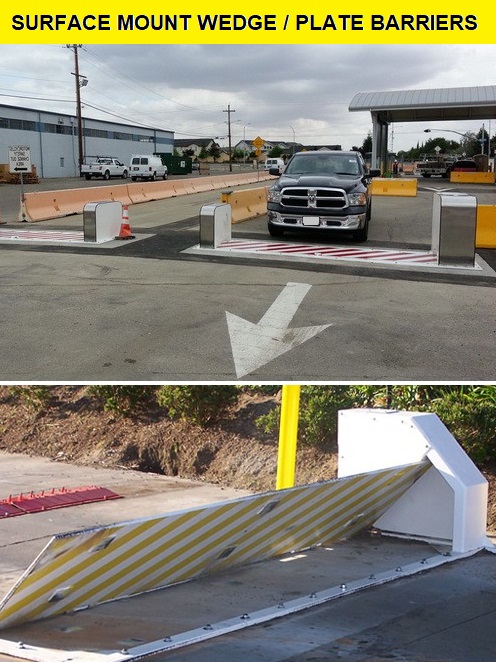The Buzz on Wedge Barriers
Table of ContentsNot known Factual Statements About Wedge Barriers The smart Trick of Wedge Barriers That Nobody is Talking About


18 might be done quicker, quickly, and cost effectively. FIG. In certain personifications, the support 30 might be a steel frame including plates, beam of lights(e. g., I-beams ), and/or other frameworks that are protected within the structure 14, which might be concrete. At the surface 12, a top side 28 of the anchor 30 might be at the very least partly revealed
, therefore making it possible for the add-on of the barrier 10 to the support 30. g., threaded holes)in one or even more light beams or plates of the support 30 might be exposed to the surface area 12. In this fashion, screws 32 or other mechanical fasteners may be utilized to protect the barrier 10 to the support 30. As the obstacle 10 is installed to the surface area 12 of the structure 14, collection of particles and various other product under the barrier might be lowered, and parts of the bather 10 may not be subjected to listed below grade environments. As shown by recommendation character 52, the training device 50 includes components disposed under the wedge plate 16. For instance, the parts 52 beneath the wedge plate 16 might consist of an electromechanical actuator, a cam, one or more web cam surfaces, and Source so forth. Additionally, the training mechanism 50 includes a springtime setting up 54
The springtime pole 58 is paired to a webcam(e. g., webcam 80 displayed in FIG. 4) of the lifting device 50. The springs 60 disposed about the spring pole 58 are held in compression by spring sustains 62, consisting of a taken care of spring assistance 64. That is, the set springtime assistance 64 is taken care of relative to the foundation 14 and the rest of the bather 10.
Excitement About Wedge Barriers
The continuing to be force used to
the cam camera deploy the wedge plate 16 may might provided by an electromechanical actuator 84 or other actuator. The springtime assembly 54 and the actuator 84(e. Wedge Barriers. g., electromechanical actuator)might operate together to convert the cam and raise the wedge plate 16.
As discussed above, the springtime assembly 54 puts in a consistent force on the camera, while the electromechanical actuator may be controlled to apply a variable force on the camera, thereby enabling the training and reducing( i. e., deploying and pulling back )of the wedge plate 16. In specific personifications, the continuous pressure applied by the springtime setting up 54 may be flexible. g., electromechanical actuator) is handicapped. As will be valued, the springtime setting up 54 might be covered and safeguarded from particles or other elements by a cover plate(e. g., cover plate 68 revealed in FIG. 4) that might be considerably flush with the raised surface 38 of the foundation 14. As mentioned over, in the released setting, the wedge plate 16 offers to obstruct accessibility or traveling beyond the barrier 10. The obstacle 10(e. g., the wedge plate 16 )may obstruct pedestrians or lorries from accessing a property or path. As discussed over, the obstacle 10 is affixed to the support 30 secured within the structure 14,

front braces 71. Consequently, the affiliation settings up 72 may pivot and revolve to enable the collapse and extension of the linkage assemblies 72 throughout retraction and implementation of the bather 10. The linkage assemblies 72 cause movement of the wedge plate 16 to be restricted. If a car is taking a trip towards the deployed wedge plate 16(e. For instance, in one situation, the safety legs 86 might be expanded duringmaintenance of the barrier 10. When the safety and security legs 86 are released, the security legs 86 support the weight of the wedge plate 16 versus the surface area 12. Consequently, the lifting system 50 may be shut off, serviced, removed, replaced, and so forth. FIG. 5 is partial perspective sight of an embodiment of the surface-mounted wedge-style obstacle 10, showing the web cam 80 and the webcam surfaces 82 of the lifting device 50. Particularly, two webcam surface areas 82, which are described as reduced cam surfaces 83, are placed listed below the webcam 80. The reduced camera surfaces 83 might be taken care of to the surface 12 (e. For instance, the reduced camera surfaces 83 and the mounting plate 85 may develop a solitary piece that is secured to the support 30 by screws or various other mechanical bolts. Additionally, 2 this post camera surfaces 82, which are referred to as upper webcam surface areas 87, are positioned above the web cam 80 and combined to (e. In other embodiments, intervening layers or plates might be positioned in between the surface area 12 and the reduced camera surfaces 83 and/or the wedge plate 16 and the upper cam surfaces 87 As mentioned above, the cam
80 translates along the web cam surface areas 82 when the wedge plate 16 is lifted from the withdrawed setting to the deployed position. Furthermore, as pointed out over, the springtime setting up 54 (see FIG. 3 )may offer a force acting upon the camera 80 in the direction 102 through springtime pole 58, which might decrease the pressure the electromechanical actuator 84 is needed to put on the camera 80 in order to activate and lift the wedge plate 16. 1 )to the deployed placement(see FIG. 4). As revealed, the camera 80 includes track wheels 104(e. g., rollers), which contact and translate along the camera surfaces 82 throughout procedure.